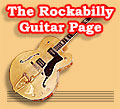 |
Vince Gordon's tips on Rockabilly guitar Amps & Effects - Guitars - Pickups - Fingerboard - Strings - The guitars I use(d)... |
Vince Gordon is the lead guitarist and singer of the rockabilly trio The Jime. |
|
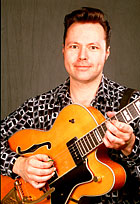 By Vince Gordon I'm often asked rockabilly guitar questions, so I have created this page that should answer most FAQ. What I express here is my personal opinion. There are - like with most things - different ways of achieving the same goals. Over the years I've had a bunch of vintage guitars. Primarily Gretsches. From Country Gentleman to Country Roc, a couple of 6120's and I've also played the odd White Falcon. I've also tried out a lot of amps. On this page you can see what I've kept - and why. You can get an "authentic" rockabilly guitar sound by following the advice, but it actually leaves you a lot of room to get your own sound. "Authentic", "neo" or even "bluesy". If you wanna check out my playing & sound you can listen to a sample of "Don't Tell me What I Want" from our CD New Set Of Rules and watch a video of "Take This Heart" from that CD. If you wanna have some fun playing with my rockabilly band, check out this new jam tracks CD "Jam With The Jime" . I wrote two eBooks about playing rockabilly guitar. One for beginners called "How to play rockabilly guitar, and get good, fast!" and one for intermediate players called "Intermediate Rockabilly Guitar Lessons". They're ready for download NOW! Go here for more rockabilly music with my rockabilly trio The Jime. A great new book on Rockabilly has just been released. I've contributed with my article on Burlison/Martin and some info on the European rockabilly scene and its bands. This would be a great reason to buy the book :-) HOWEVER! That’s not the sole reason why it's a great book :-( Many writers have contributed and all the important artists have been covered. From the fifties up till today. The weird thing about the book is that's it's actually a good read for both beginners and old-timers like me. Don't know how they did that, but they did it! This book is also full of great pics and anecdotes, but you should really check it out for yourself! Check out the reviews section to get an idea! Here's a link to it on Amazon: Rockabilly: The Twang Heard 'Round the World: The Illustrated History |
||
|
||
I never heard anything better than a Fender if we're talking about the big manufacturers. Later on, in the Guitar section, I'll also talk about Standel and EchoSonic, but they're produced in such small numbers that it's fair to say they'll only have historic interest to the most of us So...
|
Basically, when we're talking Rockabilly Guitar you've got 3 brands to choose from; Gretsch , Gibson and Fender. I'm mainly playing an Epiphone* so what do I know? No, but the truth is a little more complicated. What makes out a guitar is first and foremost the pickup's and the fingerboard . When you check almost all the guitars (except Fenders who have their own pickups) on this page you'll see that they have either DeArmond/Dynasonic, FilterTron or P-90 pickups. Seeing that 90 % of the rockabilly sound comes from having one of these pickups and a Bigsby vibrato on your guitar it doesn't really matter all that much what the guitar itself is. For instance, many cheap vintage guitars out there who just happen to have DeArmonds on them might have just the sound you're looking for. Also, DeArmond made some cheap guitars of their own that sound pretty good. *Epiphone is a daughter company of Gibson. Epiphone guitars are close in quality to Gibsons but at a much lower price.
Gretsch:As far as playing rockabilly on them I'm not impressed with the first reissues. Their shape and construction has little to do with the vintage ones they are supposed to be replicas of, the overall quality is poor but most importantly the sound is nothing to brag about, although not useless. The problem is mainly that the FilterTron pickups on those are too 'muddy'/'one-dimensional' sounding while at the same time having 'ice picky' highs. Up through the 90s Gretsch used ceramic magnets in the FilterTron's rather than the Alnico magnets they used in the vintage ones. Luckily that's in the past now as all stock FilterTron-equipped models after 5/03 have Alnico magnets, which is just one of the many improvements after Fender took over Gretsch manufactoring in January 2003. It's still not the pickup I'd pick for rockabilly though. I would either get DynaSonic (DeArmond) or TV Jones FilterTrons (Classic) pickups (Most people agree that they sound better than ANY of the reissue FilterTrons from Gretsch). You can get both stock on new Gretsches today. It's important to remember that Gretsch used DeArmound pickups (which are single-coil as opposed to the FilterTrons which are Humbuckers) in the mid-fifties and that's where the legendary Gretsch Rockabilly sound originated from. The guys who utilized that sound were such greats as Cliff Gallup (of Gene Vincent and the Blue Caps) who played a black 1955 Gretsch 6128 Duo Jet, Eddie Cochran, who played a 1955 Gretsch 6120 Hollow Body (he did however, change the neck/rhythm pickup to a P-90 from an old Gibson guitar because he found it too bright, and wanted to have the option of a mellow sound at "the flick of a switch") and Duane Eddy who played a 1957 Gretsch 6120 Hollow Body. The only rockabilly who really made the original FilterTron sound famous was/is Brian Setzer, but hey! What a sound! Jim Heat of Reverend Horton Heat is also known for playing FilterTrons and has his own Gretsch 6120 Signature guitar. So the original FilterTrons or the new "Fender-Gretsch" FilterTrons (not the Hi-Lo Trons which most people, including me, think sounds too thin) or the TV Jones FilterTrons are also great pickups for rockabilly, but the standard 90s Gretsch FilterTrons are a little tame. They ARE usable nonetheless.
Buying a Gretsch today: Gretsch 6120 Duane Eddy 1998  Gretsch 6120WCST Custom Shop 2005 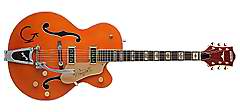 Gretsch 6120DSW Nashville Western 2005 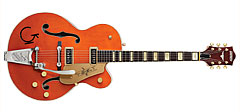 Gretsch G6120DSW Chet Atkins Hollow Body 2008 If I were to buy a Gretsch today I would pick something like the Duane Eddy signature model* (Produced from about '97-'98) with DeArmonds (DynaSonic), the new Duane Eddy model or something as close as possible to the 1955 6120 Chet Atkins "G-brand". Here's a list with the top-of-the-line (read:TOP$) choice first:
Of course there are many more Gretsch's out there - vintage and post-fender - with DeArmonds that'll do just fine and a lot of the FilterTron equipped ones are great too if you want that Setzer and Chet Atkins sound. Now that Fender have taken over manufacturing I wouldn't worry about buying any of the new high end Gretsches.* Last but not least I'd like to mention that the reissue Eddie Cochran models Gretsch 6120W-1957 Eddie Cochran and Eddie Cochran SIGNATURE Hollow Body or one of the latest Brian Setzer models would be interesting to many rockabillies. There's also a ridiculously expensive ($12.000 - $17.500 I've seen them advertised for) custom shop recreation, a so-called "relic" guitar, the G6120EC Eddie Cochran Tribute (Eddie Cochran did certainly not buy the guitar from new as the article/promotion says. He got it used from Gary Lambert who had it on loan while waiting for his new green Country Club) but you'd need a very good and possibly strange reason to buy that when there are perfectly good "cheap" alternatives. Remember, if we're talking new Gretsches for rockabilly, go for ones with DeArmonds or TV Jones pickups. (There are different versions of the DeArmond out there but they all sound pretty good - for more on the DeArmonds go to the pickup section). Gretsch Electromatic Collection Gretsch G5120 Electromatic® Hollow Body  Gretsch G5122DC Electromatic® Hollow Body 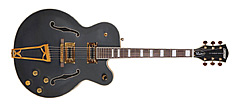 Gretsch G5191BK Tim Armstrong "Signature" Electromatic® Hollow Body Judging by the amount of mails I get about the Gretsch Electromatic Collection, these are popular guitars. They are not of high quality, but a little adjusting will always go a long way. The G5125, 5126, 5127, 5128 and 5129 (Out of production) have that original rockabilly tone because of the DeArmond 2000 pickups. The 5120 (5120 in orange) has "Gretsch dual-coil pickups" which are neither this nor that. Many people buy 5120's and put TV Jones FilterTrons or just "regular" FilterTrons on. I don't think I would do that, seeing how little a used 6120 can cost you on eBay, but I see why they're doing it. If you prefer double cutaway, then have a look at the G5122 Double Cutaway Electromatic in walnut or black finish. They come with the before mentioned "Gretsch chrome-covered Dual-Coil humbuckers" (NOT FilterTrons). The reasonably priced G5191BK Tim Armstrong "Signature" Electromatic actually comes with real FilterTrons, and is in many ways an interesting option if you can afford about $400 more than a normal 5120. It's all it's own and not just a cheap version of a 6120 which is very cool. A friend of mine tried it hands on and said the build quality was fine. I wouldn't mind one myself actually. I would put on a Bigsby though. I have this obsession you know: No guitar of mine shall go Bigsby-less. That would add an extra $100, but of course you don't have to do it (If you have it in you)...:-) A little word of "warning": The G5125's etc. are cool sounding guitars because of the DeArmonds, and if you've got one and like it but want to upgrade to get even more of that sound, think twice before you buy a 6120 with FilterTrons. A guy wrote me that he had done just that and gotten himself a Black Falcon w/FilterTrons and a dissapointment. FilterTrons are NOT DeArmonds, then don't sound anything like them. If you like the DeArmond sound on your G5125, only a 6120 with DeArmonds like the DSV or DSW will give you more of what you have already. A 6120 with FilterTrons is a totally different animal. *If you're going to buy any of the pre-Fender reissue Gretsches expect to do some upgrading on them to get them up to todays standards. For instance there are often problems with the electronics.
Gibson:Carl Perkins played a 1952/53 Les Paul Goldtop on 'Honey Don't' and other of his early recordings. Scotty Moore always played Gibson's and so did Chuck Berry and anyone else who could afford them. Many of the early Gibsons featured the now legendary P-90 pickup (comes in many different variations), which is the pickup with the most tone that I've ever heard. It also has a very naturally way of distorting and it can make your chords sound like a whole orchestra if you want it to. High end models like the Super 400CES', L5CES' and Byrdlands from '55 to around '57 featured the "AlNiCo V" (Alnico five) P-90 pickup that Seth Lower and Walt Fuller designed in 1952 to find a new sound for Gibson. (The Les Paul Custom from '54 to mid-'57 had one Alnico V in the neck position and a regular P-90 in the bridge position). Scotty Moore went from "regular" P-90's (on his ES-295) to "Alnico V" P-90's (on his L5 CESN and Super 400 CESN) in his days recording at Sun Studio with Elvis. I've seen the "Alnico V" sound described as being "noticeably clearer and with greater separation between the treble and bass strings than a typical P90." To me, the "Alnico V" sound will always be that of "Mystery Train" by Elvis/Scotty Moore/Bill Black. You can still get different vintage P-90 pickup's today from many manufactures. I use one with Alnico magnets from Seymour Duncan on my customized Ephiphone. Gibson are also making the so-called "Alnico V" pick ups again today in connection with their Historic Collection and they are calling them the "480 Alnico V single coil". I've seen it featured on the 1954 Les Paul Custom (reissue) in the rhythm position together with a "regular" P-90 in the treble position. Seymour Duncan's Custom shop is also offering the great sounding so-called Staple Pickup at $225 that is a re-issue "Alnico V". Check out my guitar with the Scotty Moore sound.
Fender:Not really my kinda guitar (not hollow bodies, ya know) but I've heard some great stuff played on them by Paul Burlison , Danny Gatton , Jimmy & Stevie Ray Vaughan, Carl Perkins, Mickey Gee (Did some great underrated stuff for Shakin' Stevens who had a dynamite band, even though I always missed the slap bass...) and Albert Lee to name a few. Maybe someday I'll stumble across one that fits my hands and I'll be all over it. The great thing about Fender Stratocasters and Telecasters is that they have single-coil pickup's that'll cut through any backing band. - and that's what rockabilly guitar is all about - isn't it? =:-) The Fender Stratocaster hasn't changed much from the original design to this day, as you can see from this picture of Strat serial number 0100 (Probably the first Stratocaster inted for retail sale).
|
|||||||||||||||||||
|
"Gretsch" pickups:...or more accurately: "pickups commonly associated with Gretsch guitars".
All the DeArmonds described "DeArmond 200" (A.K.A. Gretsch DynaSonic) (single coil) The Gretsch DynaSonics of today are exact copies of the vintage ones, and are built in Japan to Gretsh's specs. (Gretsch and Duane Eddy says they were made from the same moulds as his original 1957 6120 Chet Atkins model). They originally came with a black cover on Gretsch guitars (and others), and in white on Guild, Premier, and Levin guitars. An example of a guitar equipped with white cover DeArmond 200s would be a sixties Guild Duane Eddy. The Gretsch DynaSonics of today only come with black covers. Though many people favour the FilterTrons I must say that in my opinion the DynaSonics are THE original Gretsch Rockabilly sound. Where to buy a DynaSonic pick-up:
"DeArmond 2000" (single coil) 2000s sound a lot like the DynaSonic, but the DynaSonic still has better bass, smoother highs and better balance string-to-string. The 2000s also have that rockabilly twang though. They have one advantage over the DynaSonics in that they're made in reverse-wound/reverse-polarity pairs for hum cancellation so that when you put the pick-up switch in middle position they act like a humbucker. If you have a guitar with 2000s that hum in the middle position you might wanna experiment with the wiring as it seems some guitars have been wired wrong from the factory. The 2000s are made in the USA by Fender and come with both black and white covers - black for Gretsch and white for Guild (as usual). Many 2000s have been passed of for being DynaSonics. Gretsch Streamliners and Synchromatics had them, even though they were called "DynaSonics" until Fender took over. Likewise the Guild X160 Rockabilly has been marketed as having 2ks while they in fact never had anything but 2000s. "DeArmond 2k" (single coil) Comes both with black or white cover and with a square chrome plated metal cover or one with an elongated "V" cut-out on each of the two short ends.
"FilterTron" (humbucker) Where to buy a FilterTron pick-up: "HiLoTron" (single coil) Where to buy a HiLoTron pick-up: Much more on the 'Trons coming later...
|
Whatever suits you. There are no special requirements for a Rockabilly Guitar fingerboard. Mind you, if you want to do fingerpicking, jumbo frets and a narrow neck will always be a bad choice. That's a set up for bending, not for picking barre chords.
Choosing a Rockabilly Guitar: A guitar may sound great, but if it's hard to play for you, you're not doing yourself a favour. Find out why it sounds good and look for that in another guitar that's easy to play. They're supposed to be! Technique shouldn't stand in the way of music. Remember that you can go a long way with having a prof. guitar tech. adjusting a 'bad' guitar. Always have a new guitar adjusted to fit YOUR hands and way of playing.
|
Basically there are no 'right' or 'wrong' strings for Rockabilly. It's a matter of taste. As a rule you can say that heavy strings give you a 'fat', dark sound and light strings give you a 'thin', bright sound. Pretty simple, ay? Also, roundwounds are brighter and flatwounds are darker (more jazzy). If you're looking for the Scotty Moore sound you'll want heavier strings than you normally use in rock. Go for .012 flatwounds or more. Scotty Moore used flatwounds on "Mystery Train" and roundwounds on "That's All Right Mama". Today - because he doesn't have the same strength in his hands - he plays D'Addario .010-.046 half-wounds where they grind down a .018 wound third to .017 for him. He told me this when I was lucky enough to meet him together with DJ Fontana in March '98. I'm mentioning this because there's a funny story that goes with it: ----- After I finished asking Mr. Moore several gear questions I asked him what kinda music he listened to nowadays. He said he listened to Jazz as he always had and he mentioned quite a few names, that I regrettably can't remember. Because he said Jazz, I asked him what he thought about the Brian Setzer Orchestra who were pretty big at the time and he lit up and said he was a fan. Then I turned to DJ Fontana who stood there waiting for Mr. Moore to follow him to the limo and had overheard our conversation and I asked him; "..so what are you into these days?". "Television!" he said. ----- In the fifties you actually couldn't get any lighter strings (.010 for instance), like we know them today. They just didn't make them. So if you're going for an authentic sound, you'll be on the safe size using heavy (by today's standards) strings (.012+). Technically speaking .012/.013 strings are called 'medium' but I consider that to be misleading. In practice, when it comes to rock, I've found that it makes more sense to categorize .010/.011 as 'medium' and sizes below as 'light' and sizes above as 'heavy'. I only know of two guys back then using string sizes that can be compared to the lighter ones used today. Eddie Cochran used a second string instead of a wound third and James Burton (Played with Ricky Nelson among others) used banjo strings for the thin strings and then moved the "thin" guitar strings down and threw the heavy ones away (I guess!). I settled for a middle-of-the-road set of strings: Ernie Ball .010-.046 (Regular Slinky). I would have preferred to play a .011 set because they just feel better in my hands, but there is so much bass in them (On MY guitars) that it meddles with the territory of the double bass. The .010's also allow me to get a 'twangy' sound when I need it. Something that's hard to get with heavy strings. Originally, I tried out all the major brands to find 'my' strings. I would advice you to do the same. It doesn't cost extra if you try out one brand/size at a time and no one but yourself can tell what strings are the best for you. - New strings should be stretched (bended) a little so the tuning is more stable. - If you hate changing strings (like me!), a stringwinder makes the job a bit easier.
|
How to cut feedback in hollow body guitarsThere can be many different sources for feedback with amplified hollow body instruments (Rockabilly upright bass players often have very similar problems as guitarists do btw.) Playing too loud is the most obvious one, but even at moderate volume one can have serious feedback problems. A pickup change, an equalizer to suppress the feeding frequencies, cutting the bass, not using distortion pedals and a number of other solutions are available. However these solutions are general for all amplified music styles, which means you can easily find information on them elsewhere so I won't go into that here. The typical rockabilly related feedback problem comes from the actual body of hollow body guitars. As opposed to a solid body guitar which is made out of one* heavy piece of wood, the light top* of a hollow body guitar is often free to vibrate much more, especially with open f-holes where there is a long edge of wood not attached to anything. When the top moves at the same Hz as the sound waves hitting it (coming from the amp/monitor) you get feedback, because the pickups of course (they are attached to the top!) also start vibrating at that same Hz, that then again goes back into the amp, thereby creating a loop of that frequency being amplified over and over. *can of course be laminated Q: What's the solution? A: Keep the top from moving so freely. Q: How? A: Basically anything that will slow down the top will work. Adding weight and/or structure and stiffness is the way to go. Here are three solutions that are common and are known to work: Have you checked out? A real rockabilly band to play along to: 1. Tape up the f-holes (if any!) (The tape may ruin the finish) 2. Stuff the guitar with padding I advise you to stuff your guitar so that it can be undone. I used building polyurethane foam out of a spray can on my Epiphone. It works, but the drawbacks are that it can hardly be undone and I have problems accessing the wires and electrics. I wanted a permanent solution however, because I set up the guitar to be my main instrument for concerts. Today I would have tried installing a soundpost first or using Fiberfill. Stuffing a guitar will "damage" the tone of your instrument more than installing a soundpost. In real life this might not be a problem at all, because a hollow body guitar really isn't an acoustic instrument anymore once it has pickups on but rather an electric one. I know a lot of rockabilly slap bass players will agree with me, that the acoustic abilities of their instruments often only get in the way of creating a good amplified sound. 3. Install a "soundpost" It's an invention coming from the field of classical instruments, like violins and upright basses where they use it to control the tone of the instrument and give it structural strength. On an amplified instrument however, it can also be used to cut feedback because it stiffens the top (among other things). Where you place that soundpost will have an effect on the sustain and tone of the instrument and can enhance them. You can experiment with that. It is not recommended to glue the soundpost in place, as you might later want to remove it or move it. The soundpost can be installed through the "lower" f-hole for instance. On these pages from a violin luthier you'll find the concept of a soundpost and how to install one beautifully explained with diagrams and photos. Here's another good site on installing a soundpost. It's probably a good idea to have a luthier install the soundpost for you. 4. Combine the solutions Remember: Whatever you do, it's at your own risk.
|
For my recordings:
A customized 1997 Epiphone Emperor Regent with one Seymour Duncan vintage P-90 (SP90-1, Alnico 5 bar magnets) and one vintage FilterTron pickup (1964) and a vintage Bigsby whammy bar (As featured on the cover of 'Mean Side Of Town'). My main instrument and used on most of my recordings including "Anyhow". Originally I bought it because I was looking for something reliable, replaceable and cheap (Compared to my vintage Gretsches) to use on stage. I picked this model because it had a great fingerboard, was even bigger than my '55 6120 G-brand (1½ inches wider!) and reminded me of Scotty Moore's L-5 (I later found out that the 17" wide body actually was modelled after the Gibson L-5 cutaway). Apart from that it was on sale. At least that's what I was told. I later found out I pretty much paid the standard retail price ~:-(
A 1955 Gretsch 6120 Chet Atkins Hollow Body G-brand with 2 DeArmond DynaSonic pickup's. Used on "Gotto Be", "A Little More Time", "Don't Tell Me What I Want"and "From Day To Day" among others.
A 1954 Gibson ES 175D with 2 P-90 pickup's. Used on mid-eighties The Jime recordings (Unreleased).
Besides these electrics I have about 5 no-name acoustics that are very hard to play, but record very well. Newsletter:If you read this far there's a good chance you will want to sign up for my newsletter. It covers both The Rockabilly Guitar Page and my trio The Jime. Expect to receive max. 6 mails pr. year. Subjects are: New rockabilly guitar info, the tutorial book I wrote called "How to play rockabilly guitar, and get good, fast!" and new CDs.
Vince Gordon Check out my CDs here.
|